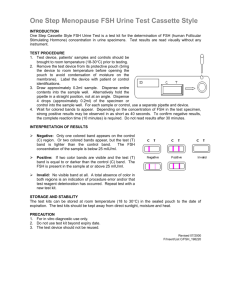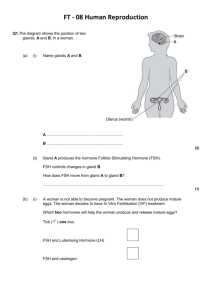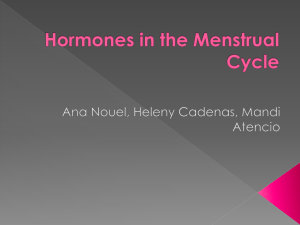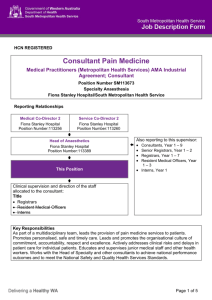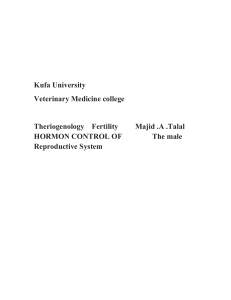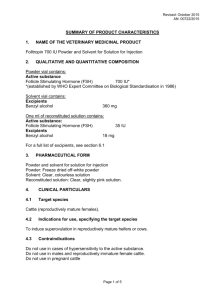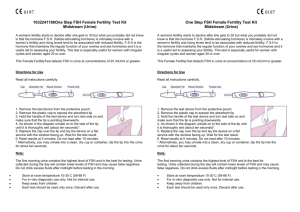FSH enzyme immunoassay test kit
advertisement
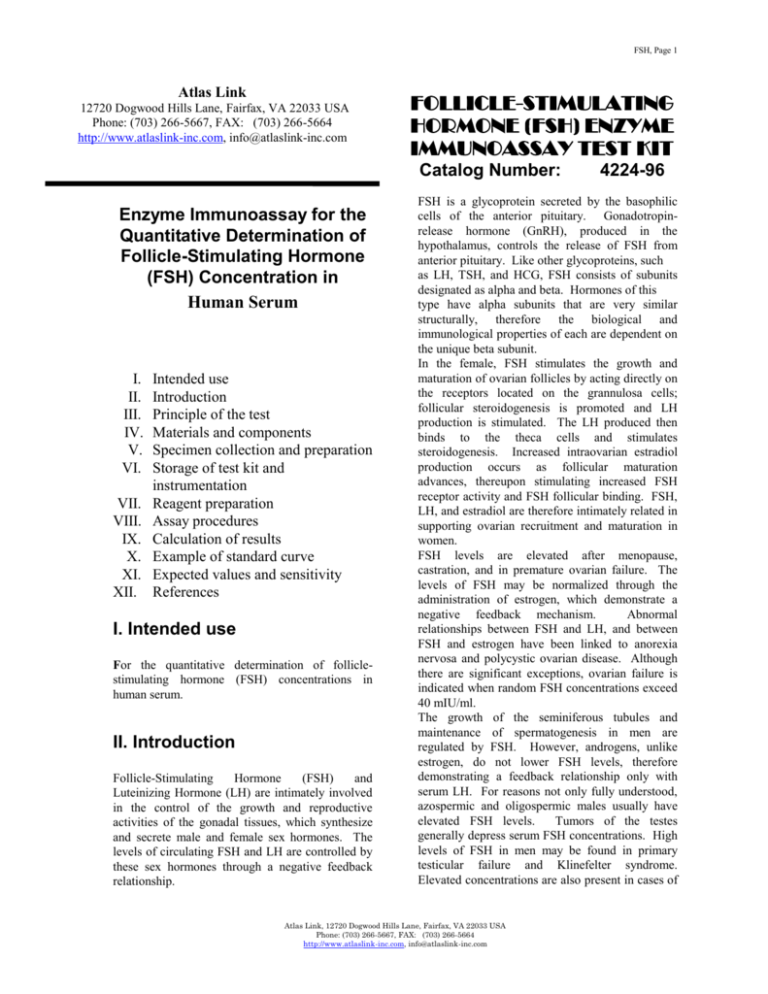
FSH, Page 1 Atlas Link 12720 Dogwood Hills Lane, Fairfax, VA 22033 USA Phone: (703) 266-5667, FAX: (703) 266-5664 http://www.atlaslink-inc.com, info@atlaslink-inc.com FOLLICLE-STIMULATING HORMONE (FSH) ENZYME IMMUNOASSAY TEST KIT Catalog Number: Enzyme Immunoassay for the Quantitative Determination of Follicle-Stimulating Hormone (FSH) Concentration in Human Serum I. II. III. IV. V. VI. VII. VIII. IX. X. XI. XII. Intended use Introduction Principle of the test Materials and components Specimen collection and preparation Storage of test kit and instrumentation Reagent preparation Assay procedures Calculation of results Example of standard curve Expected values and sensitivity References I. Intended use For the quantitative determination of folliclestimulating hormone (FSH) concentrations in human serum. II. Introduction Follicle-Stimulating Hormone (FSH) and Luteinizing Hormone (LH) are intimately involved in the control of the growth and reproductive activities of the gonadal tissues, which synthesize and secrete male and female sex hormones. The levels of circulating FSH and LH are controlled by these sex hormones through a negative feedback relationship. 4224-96 FSH is a glycoprotein secreted by the basophilic cells of the anterior pituitary. Gonadotropinrelease hormone (GnRH), produced in the hypothalamus, controls the release of FSH from anterior pituitary. Like other glycoproteins, such as LH, TSH, and HCG, FSH consists of subunits designated as alpha and beta. Hormones of this type have alpha subunits that are very similar structurally, therefore the biological and immunological properties of each are dependent on the unique beta subunit. In the female, FSH stimulates the growth and maturation of ovarian follicles by acting directly on the receptors located on the grannulosa cells; follicular steroidogenesis is promoted and LH production is stimulated. The LH produced then binds to the theca cells and stimulates steroidogenesis. Increased intraovarian estradiol production occurs as follicular maturation advances, thereupon stimulating increased FSH receptor activity and FSH follicular binding. FSH, LH, and estradiol are therefore intimately related in supporting ovarian recruitment and maturation in women. FSH levels are elevated after menopause, castration, and in premature ovarian failure. The levels of FSH may be normalized through the administration of estrogen, which demonstrate a negative feedback mechanism. Abnormal relationships between FSH and LH, and between FSH and estrogen have been linked to anorexia nervosa and polycystic ovarian disease. Although there are significant exceptions, ovarian failure is indicated when random FSH concentrations exceed 40 mIU/ml. The growth of the seminiferous tubules and maintenance of spermatogenesis in men are regulated by FSH. However, androgens, unlike estrogen, do not lower FSH levels, therefore demonstrating a feedback relationship only with serum LH. For reasons not only fully understood, azospermic and oligospermic males usually have elevated FSH levels. Tumors of the testes generally depress serum FSH concentrations. High levels of FSH in men may be found in primary testicular failure and Klinefelter syndrome. Elevated concentrations are also present in cases of Atlas Link, 12720 Dogwood Hills Lane, Fairfax, VA 22033 USA Phone: (703) 266-5667, FAX: (703) 266-5664 http://www.atlaslink-inc.com, info@atlaslink-inc.com FSH, Page 2 starvation, renal failure, hyperthyroidism, and cirrhosis. techniques. This kit is for use with serum samples without additives only. III. Principle of the test VI. Storage of test kits and instrumentation The FSH Quantitative Test Kit is based on the principle of a solid phase enzyme-linked immunosorbent assay. The assay system utilizes a polyclonal anti-FSH antibody for solid phase (microtiter wells) immobilization and a mouse monoclonal anti-FSH antibody in the antibodyenzyme (horseradish peroxidase) conjugate solution. The test sample is allowed to react simultaneously with the antibodies, resulting in FSH molecules being sandwiched between the solid phase and enzyme-linked antibodies. After a 60 minute incubation at room temperature, the wells are washed with water to remove unbound labeled antibodies. A solution of TMB is added and incubated for 20 minutes, resulting in the development of a blue color. The color development is stopped with the addition of 2N HCl, and the color is changed to yellow and measured spectrophotometrically at 450 nm. The concentration of FSH is directly proportional to the color intensity of the test sample. Unopened test kits should be stored at 2-8C upon receipt and the microtiter plate should be kept in a sealed bag with desiccants to minimize exposure to damp air. Opened test kits will remain stable until the expiring date shown, provided it is stored as prescribed above. A microtiter plate reader with a bandwidth of 10nm or less and an optical density range of 0-2 OD or greater at 450nm wavelength is acceptable for use in absorbance measurement. VII. Reagent preparation 1. 2. IV. Materials and components 3. Materials provided with the test kits: Antibody-coated microtiter wells. Reference standard set, contains 0, 7.5, 25, 60, 120, and 240 mIU/ml (WHO, 2nd IRP, HMG) human FSH, lyophilized. Enzyme conjugate reagent, 13 ml. Color Reagent A, 13 ml. Color Reagent B, 13 ml. 2N HCl, 10 ml. Materials required but not provided: Precision pipettes: 0.05, 0.1, 0.2, and 1.0 ml. Disposable pipette tips. Distilled water. Glass tubes or flasks to mix Color Reagent A and Color Reagent B. Vortex mixer or equivalent. Absorbent paper or paper towel. Graph paper. Microtiter well reader. VIII. Assay procedures 1. 2. 3. 4. 5. 6. V. Specimen collection and preparation Serum should be prepared from a whole blood specimen obtained by acceptable medical All reagent should be brought to room temperature (18-25C ) before use. To prepare TMB solution, make an 1:1 mixing of Color Reagent A with Color Reagent B up to 1 hour before use. Mix gently to ensure complete mixing. The prepared TMB substrate reagent is stable at room temperature in the dark for up to 3 hours. Discard the excess after use. Reconstitute each lyophilized standard with 1.0ml distilled water. Allow the reconstituted material to stand for at least 20 minutes. Reconstituted standards should be stored sealed at 2-8C. 7. Secure the desired number of coated wells in the holder. Dispense 50l of standard, specimens, and controls into appropriate wells. Dispense 100l of Enzyme Conjugate Reagent into each well. Thoroughly mix for 30 seconds. It is very important to have complete mixing in this setup. Incubate at room temperature (18-25C) for 60 minutes. Prepare TMB solution up to one hour before use. Remove the incubation mixture by flicking plate content into a waste container. Rinse and flick the microtiter wells 5 times with running tap or distilled water. Atlas Link, 12720 Dogwood Hills Lane, Fairfax, VA 22033 USA Phone: (703) 266-5667, FAX: (703) 266-5664 http://www.atlaslink-inc.com, info@atlaslink-inc.com FSH, Page 3 8. 9. 10. 11. 12. 13. Strike the wells sharply onto absorbent paper or paper towels to remove all residual water droplets. Dispense 200l of TMB solution into each well. Gently mix for 5 seconds. Incubate at room temperature in the dark for 20 minutes. Stop the reaction by adding 50l of 2N HCl to each well. Gently mix for 30 seconds. It is important to make sure that all the blue color changes to yellow color completely. Read optical density at 450nm with a microtiter reader within 30 minutes. 3 2.5 2 OD 1.5 1 0.5 Important Note: The wash procedure is critical. Insufficient washing will result in poor precision and falsely elevated absorbances readings. 0 0 50 100 150 200 250 Conc. of FSH (mIU/ml) IX. Calculation of results Calculate the mean absorbance value (A450) for each set of reference standards, specimens, controls and patient samples. Constructed a standard curve by plotting the mean absorbance obtained from each reference standard against its concentration in mIU/ml on graph paper, with absorbance values on the vertical or Y axis and concentrations on the horizontal or X axis. Use the mean absorbance values for each specimen to determine the corresponding concentration of FSH in mIU/ ml from the standard curve. XI. Expected values and sensitivity Based on random selected out-patient clinical laboratory samples, the mean FSH values in males (N=100) and females (N=150) are 11 and 12 mIU/ml, respectively. The mean FSH values in post-menopausal (N=60) and pregnant females (N=60) are 94 and 1.0 mIU/ml, respectively. The minimum detectable concentration of FSH by this assay is estimated to be 2.5 mIU/ml. X. Example of standard curve Results of typical standard run with optical density reading at 450nm shown in the Y- axis against FSH concentrations shown in the X-axis. This standard curve is for the purpose of illustration only, and should not be used to calculate unknowns. Each user should obtain his or her own data and standard curve. FSH (mIU/ml) 0 7.5 25 60 120 240 Absorbance (450nm) 0.007 0.095 0.316 0.749 1.477 2.584 XII. References 1. 2. 3. 4. 5. Marshall J.C. Clinic in Endocrinol. Metab 1975; 4:545 Cohen K.L. Mtabolism 1977; 26:1165 Rebar R.W. , Erickson G.F. and Yen S.S.C. Fertil. Steril. 1982; 37: 35 Abraham G.E.. Ed. Radioassay Systems in Clinic. Endocrinol. Marcel Dekker, Inc,, New York (1981) Uotila M., Ruoslahti E and Engvall E. J. Immunol. Methods 1981; 42: 11 Atlas Link, 12720 Dogwood Hills Lane, Fairfax, VA 22033 USA Phone: (703) 266-5667, FAX: (703) 266-5664 http://www.atlaslink-inc.com, info@atlaslink-inc.com
